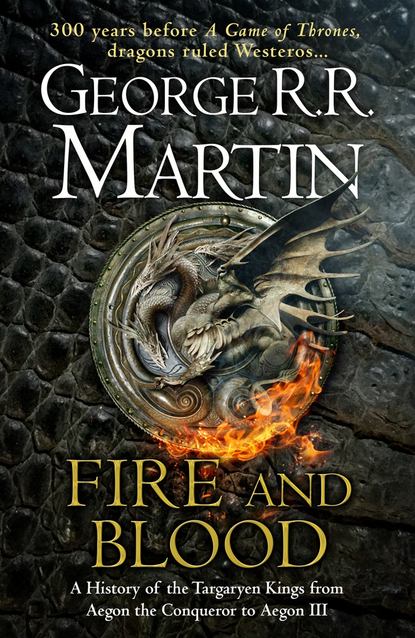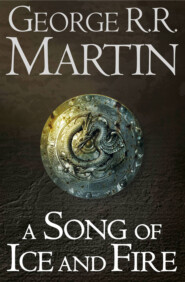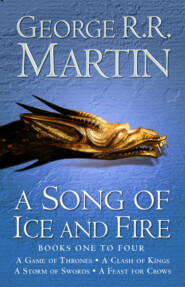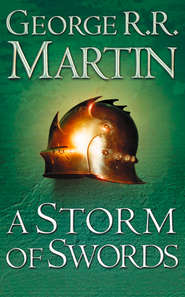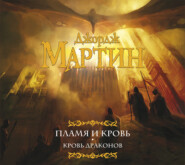По всем вопросам обращайтесь на: info@litportal.ru
(©) 2003-2024.
✖
Fire and Blood
Год написания книги
2019
Настройки чтения
Размер шрифта
Высота строк
Поля
Written there were the names of twenty men alleged to have given their seed to Queen Alys. Old men and young, handsome men and homely ones, knights and squires, lords and servants, even grooms and smiths and singers; the King’s Hand had cast a wide net, it seemed. The men had only one thing in common: all were men of proven potency known to have fathered healthy children.
Under torture, all but two confessed. One, a father of twelve, still had the gold paid him by Lord Harroway for his services. The questioning was carried out swiftly and secretly, so Lord Harroway and Queen Alys had no inkling of the king’s suspicions until the Kingsguard burst in on them. Dragged from her bed, Queen Alys saw her sisters killed before her eyes as they tried to protect her. Her father, inspecting the Tower of the Hand, was flung from its roof to smash upon the stones below. Harroway’s sons, brothers, and nephews were taken as well. Thrown onto the spikes that lined the dry moat around Maegor’s Holdfast, some took hours to die; the simpleminded Horas Harroway lingered for days. The twenty names on Queen Tyanna’s list soon joined them, and then another dozen men, named by the first twenty.
The worst death was reserved for Queen Alys herself, who was given over to her sister-wife Tyanna for torment. Of her death we will not speak, for some things are best buried and forgotten. Suffice it to say that her dying took the best part of a fortnight, and that Maegor himself was present for all of it, a witness to her agony. After her death, the queen’s body was cut into seven parts, and her pieces mounted on spikes above the seven gates of the city, where they remained until they rotted.
King Maegor himself departed King’s Landing, assembling a strong force of knights and men-at-arms and marching on Harrenhal to complete the destruction of House Harroway. The great castle on the Gods Eye was lightly held, and its castellan, a nephew of Lord Lucas and cousin to the late queen, opened his gates at the king’s approach. Surrender did not save him; His Grace put the entire garrison to the sword, along with every man, woman, and child he found to have any drop of Harroway blood. Then he marched to Lord Harroway’s Town on the Trident and did the same there.
In the aftermath of the bloodletting, men began to say that Harrenhal was cursed, for every lordly house to hold it had come to a bad and bloody end. Nonetheless, many ambitious king’s men coveted Black Harren’s mighty seat, with its broad and fertile lands … so many that King Maegor grew weary of their entreaties, and decreed that Harrenhal should go to the strongest of them. Thus did twenty-three knights of the king’s household fight with sword and mace and lance amidst the blood-soaked streets of Lord Harroway’s Town. Ser Walton Towers emerged victorious, and Maegor named him Lord of Harrenhal … but the melee had been a savage affray, and Ser Walton did not live long enough to enjoy his lordship, dying of his wounds within the fortnight. Harrenhal passed to his eldest son, though its domains were much diminished, as the king granted Lord Harroway’s Town to Lord Alton Butterwell, and the rest of the Harroway holdings to Lord Darnold Darry.
When at last Maegor returned to King’s Landing to seat himself again upon the Iron Throne, he was greeted with the news that his mother, Queen Visenya, had died. Moreover, in the confusion that followed the death of the Queen Dowager, Queen Alyssa and her children had made their escape from Dragonstone, with the dragons Vermithor and Silverwing … to where, no man could say. They had even gone so far as to steal Dark Sister as they fled.
His Grace ordered his mother’s body burned, her bones and ashes interred beside those of the Conqueror. Then he sent his Kingsguard to seize his squire, Prince Viserys. “Chain him in a black cell and question him sharply,” Maegor commanded. “Ask him where his mother has gone.”
“He may not know,” protested Ser Owen Bush, a knight of Maegor’s Kingsguard. “Then let him die,” the king answered famously. “Perhaps the bitch will turn up for his funeral.”
Prince Viserys did not know where his mother had gone, not even when Tyanna of Pentos plied him with her dark arts. After nine days of questioning, he died. His body was left out in the ward of the Red Keep for a fortnight, at the king’s command. “Let his mother come and claim him,” Maegor said. But Queen Alyssa never appeared, and at last His Grace consigned his nephew to the fire. The prince was fifteen years old when he was killed, and had been much loved by smallfolk and lords alike. The realm wept for him.
In 45 AC, construction finally came to an end on the Red Keep. King Maegor celebrated its completion by feasting the builders and workmen who had labored on the castle, sending them wagonloads of strongwine and sweetmeats, and whores from the city’s finest brothels. The revels lasted for three days. Afterward, the king’s knights moved in and put all the workmen to the sword, to prevent them from ever revealing the Red Keep’s secrets. Their bones were interred beneath the castle that they had built.
Not long after the completion of the castle, Queen Ceryse was stricken with a sudden illness and passed away. A rumor went around the court that Her Grace had given offense to the king with a shrewish remark, so he had commanded Ser Owen to remove her tongue. As the tale went, the queen had struggled, Ser Owen’s knife had slipped, and the queen’s throat had been slit. Though never proven, this story was widely believed at the time; today, however, most maesters believe it to be a slander concocted by the king’s enemies to further blacken his repute. Whatever the truth, the death of his first wife left Maegor with but a single queen, the black-haired, black-hearted Pentoshi woman Tyanna, mistress of the spiders, who was hated and feared by all.
Hardly had the last stone been set on the Red Keep when Maegor commanded that the ruins of the Sept of Remembrance be cleared from the top of Rhaenys’s Hill, and with them the bones and ashes of the Warrior’s Sons who had perished there. In their place, he decreed, a great stone “stable for dragons” would be erected, a lair worthy of Balerion, Vhagar, and their get. Thus commenced the building of the Dragonpit. Perhaps unsurprisingly, it proved difficult to find builders, stonemasons, and laborers to work on the project. So many men ran off that the king was finally forced to use prisoners from the city’s dungeons as his workforce, under the supervision of builders brought in from Myr and Volantis.
Late in the year 45 AC, King Maegor took the field once again to continue his war against the outlawed remnants of the Faith Militant, leaving Queen Tyanna to rule King’s Landing together with the new Hand, Lord Edwell Celtigar. In the great wood south of the Blackwater, the king’s forces hunted down scores of Poor Fellows who had taken refuge there, sending many to the Wall and hanging those who refused to take the black. Their leader, the woman known as Poxy Jeyne Poore, continued to elude the king until at last she was betrayed by three of her own followers, who received pardons and knighthoods as their reward.
Three septons traveling with His Grace declared Poxy Jeyne a witch, and Maegor ordered her to be burned alive in a field beside the Wendwater. When the day appointed for her execution came, three hundred of her followers, Poor Fellows and peasants all, burst from the woods to rescue her. The king had anticipated this, however, and his men were ready for the attack. The rescuers were surrounded and slaughtered. Amongst the last to die was their leader, who proved to be Ser Horys Hill, the bastard hedge knight who had escaped the carnage at the Great Fork three years earlier. This time he proved less fortunate.
Elsewhere in the realm, however, the tide of the times had begun to turn against the king. Smallfolk and lords alike had come to despise him for his many cruelties, and many began to give help and comfort to his enemies. Septon Moon, the “High Septon” raised up by the Poor Fellows against the man in Oldtown they called the High Lickspittle, roamed the riverlands and Reach at will, drawing huge crowds whenever he emerged from the woods to preach against the king. The hill country north of the Golden Tooth was ruled in all but name by the Red Dog, Ser Joffrey Doggett, self-proclaimed Grand Captain of the Warrior’s Sons. Neither Casterly Rock nor Riverrun seemed inclined to move against him. Dennis the Lame and Ragged Silas remained at large, and wherever they roamed, smallfolk helped keep them safe. Knights and men-at-arms sent out to bring them to justice oft vanished.
In 46 AC, King Maegor returned to the Red Keep with two thousand skulls, the fruits of a year of campaigning. They were the heads of Poor Fellows and Warrior’s Sons, he announced, as he dumped them out beneath the Iron Throne … but it was widely believed that many of the grisly trophies belonged to simple crofters, fieldhands, and swineherds guilty of no crime but faith.
The coming of the new year found Maegor still without a son, not even a bastard who might be legitimized. Nor did it seem likely that Queen Tyanna would give him the heir that he desired. Whilst she continued to serve His Grace as mistress of whisperers, the king no longer sought her bed.
It was past time for him to take a new wife, Maegor’s counselors agreed … but they parted ways on who that wife should be. Grand Maester Benifer suggested a match with the proud and lovely Lady of Starfall, Clarisse Dayne, in the hopes of detaching her lands and house from Dorne. Alton Butterwell, master of coin, offered his widowed sister, a stout woman with seven children. Though admittedly no beauty, he argued, her fertility had been proved beyond a doubt. The King’s Hand, Lord Celtigar, had two young maiden daughters, thirteen and twelve years of age respectively. He urged the king to take his pick of them, or marry both if he preferred. Lord Velaryon of Driftmark advised Maegor to send for his niece Rhaena, the widow of Aegon the Uncrowned. By taking her to wife, Maegor could unite their claims, prevent any fresh rebellions from gathering around her, and acquire a hostage against any plots her mother, Queen Alyssa, might foment.
King Maegor listened to each man in turn. Though in the end he scorned most of the women they put forward, some of their reasons and arguments took root in him. He would have a woman of proven fertility, he decided, though not Butterwell’s fat and homely sister. He would take more than one wife, as Lord Celtigar urged. Two wives would double his chances of getting a son; three wives would triple it. And one of those wives should surely be his niece; there was wisdom in Lord Velaryon’s counsel. Queen Alyssa and her two youngest children remained in hiding (it was thought that they had fled across the narrow sea, to Tyrosh or perhaps Volantis), but they still represented a threat to Maegor’s crown, and any son he might father. Taking Aenys’s daughter to wife would weaken any claims put forward by her younger siblings.
After the death of her husband and her flight to Fair Isle, Rhaena Targaryen had acted quickly to protect her daughters. If Prince Aegon had truly been the king, by law his eldest daughter, Aerea, stood his heir, and might therefore claim to be the rightful Queen of the Seven Kingdoms … but Aerea and her sister, Rhaella, were barely a year old, and Rhaena knew that to trumpet such claims would be tantamount to condemning them to death. Instead, she dyed their hair, changed their names, and sent them from her, entrusting them to certain powerful allies, who would see them fostered in good homes by worthy men who would have no inkling of their true identities. Even their mother must not know where the girls were going, the princess insisted; what she did not know she could not reveal, even under torture.
No such escape was possible for Rhaena Targaryen herself. Though she could change her name, dye her hair, and garb herself in a tavern wench’s roughspun or the robes of a septa, there was no disguising her dragon. Dreamfyre was a slender, pale blue she-dragon with silvery markings who had already produced two clutches of eggs, and Rhaena had been riding her since the age of twelve.
Dragons are not easily hidden. Instead the princess took them both as far from Maegor as she could, to Fair Isle, where Marq Farman granted her the hospitality of Faircastle, with its tall white towers rising high above the Sunset Sea. And there she rested, reading, praying, wondering how long she would be given before her uncle sent for her. Rhaena never doubted that he would, she said afterward; it was a question of when, not if.
The summons came sooner than she would have liked, though not as soon as she might have feared. There was no question of defiance. That would only bring the king down on Fair Isle with Balerion. Rhaena had grown fond of Lord Farman, and more than fond of his second son, Androw. She would not repay their kindness with fire and blood. She mounted Dreamfyre and flew to the Red Keep, where she learned that she must marry her uncle, her husband’s killer. And there as well Rhaena met her fellow brides, for this was to be a triple wedding.
Lady Jeyne of House Westerling had been married to Alyn Tarbeck, who had died with Prince Aegon in the Battle Beneath the Gods Eye. A few months later, she had given her late lord a posthumous son. Tall and slender, with lustrous brown hair, Lady Jeyne was being courted by a younger son of the Lord of Casterly Rock when Maegor sent for her, but this meant little and less to the king.
More troubling was the case of Lady Elinor of House Costayne, the wife of Ser Theo Bolling, a landed knight who had fought for the king in his last campaign against the Poor Fellows. Though only nineteen, Lady Elinor had already given Bolling three sons when the king’s eye fell upon her. The youngest boy was still at her breast when Ser Theo was arrested by the Kingsguard and charged with conspiring with Queen Alyssa to murder the king and place the boy Jaehaerys on the Iron Throne. Though Bolling protested his innocence, he was found guilty and beheaded the same day. King Maegor gave his widow seven days to mourn, in honor of the gods, then summoned her to tell her they would marry.
At the town of Stoney Sept, Septon Moon denounced King Maegor’s wedding plans, and hundreds of townfolk cheered wildly, but few others dared to raise their voices against His Grace. The High Septon took ship at Oldtown, sailing to King’s Landing to perform the marriage rites. On a warm spring day in the 47th year After the Conquest, Maegor Targaryen took three wives in the ward of the Red Keep. Though each of his new queens was garbed and cloaked in the colors of her father’s house, the people of King’s Landing called them “the Black Brides,” for all were widows.
The presence of Lady Jeyne’s son and Lady Elinor’s three boys at the wedding ensured that they would play their parts in the ceremony, but there were many who expected some show of defiance from Princess Rhaena. Such hopes were quelled when Queen Tyanna appeared, escorting two young girls with silver hair and purple eyes, clad in the red and black of House Targaryen. “You were foolish to think you could hide them from me,” Tyanna told the princess. Rhaena bowed her head and spoke her vows in a voice as cold as ice.
Many queer and contradictory stories are told of the night that followed, and with the passage of so many years it is difficult to separate truth from legends. Did the three Black Brides share a single bed, as some claim? It seems unlikely. Did His Grace visit all three women during the night and consummate all three unions? Perhaps. Did Princess Rhaena attempt to kill the king with a dagger concealed beneath her pillows, as she later claimed? Did Elinor Costayne scratch the king’s back to bloody ribbons as they coupled? Did Jeyne Westerling drink the fertility potion that Queen Tyanna supposedly brought her, or throw it in the older woman’s face? Was such a potion ever mixed or offered? The first account of it does not appear until well into the reign of King Jaehaerys, twenty years after both women were dead.
This we know. In the aftermath of the wedding, Maegor declared Rhaena’s daughter Aerea his lawful heir “until such time as the gods grant me a son,” whilst sending her twin, Rhaella, to Oldtown to be raised as a septa. His nephew Jaehaerys, the rightful heir by all the laws of the Seven Kingdoms, was expressly disinherited in the same decree. Queen Jeyne’s son was confirmed as Lord of Tarbeck Hall, and sent to Casterly Rock to be raised as a ward of Lyman Lannister. Queen Elinor’s elder boys were similarly disposed of, one to the Eyrie, one to Highgarden. The queen’s youngest babe was turned over to a wet nurse, as the king found the queen’s nursing irksome.
Half a year later, Edwell Celtigar, the King’s Hand, announced that Queen Jeyne was with child. Hardly had her belly begun to swell when the king himself revealed that Queen Elinor was also pregnant. Maegor showered both women with gifts and honors, and granted new lands and offices to their fathers, brothers, and uncles, but his joy proved to be short-lived. Three moons before she was due, Queen Jeyne was brought to bed by a sudden onset of labor pains, and was delivered of a stillborn child as monstrous as the one Alys Harroway had birthed, a legless and armless creature possessed of both male and female genitalia. Nor did the mother long survive the child.
Maegor was cursed, men said. He had slain his nephew, made war against the Faith and the High Septon, defied the gods, committed murder and incest, adultery and rape. His privy parts were poisoned, his seed full of worms, the gods would never grant him a living son. Or so the whispers ran. Maegor himself settled on a different explanation, and sent Ser Owen Bush and Ser Maladon Moore to seize Queen Tyanna and deliver her to the dungeons. There the Pentoshi queen made a full confession, even as the king’s torturers readied their implements: she had poisoned Jeyne Westerling’s child in the womb, just as she had Alys Harroway’s. It would be the same with Elinor Costayne’s whelp, she promised.
It is said that the king slew her himself, cutting out her heart with Blackfyre and feeding it to his dogs. But even in death, Tyanna of the Tower had her revenge, for it came to pass just as she had promised. The moon turned and turned again, and in the black of night Queen Elinor too was delivered of a malformed and stillborn child, an eyeless boy born with rudimentary wings.
That was in the 48th year After the Conquest, the sixth year of King Maegor’s reign, and the last year of his life. No man in the Seven Kingdoms could doubt that the king was accursed now. What followers still remained to him began to melt away, evaporating like dew in the morning sun. Word reached King’s Landing that Ser Joffrey Doggett had been seen entering Riverrun, not as a captive but as a guest of Lord Tully. Septon Moon appeared once more, leading thousands of the Faithful on a march across the Reach to Oldtown, with the announced intent of bearding the Lickspittle in the Starry Sept to demand that he denounce “the Abomination on the Iron Throne,” and lift his ban on the military orders. When Lord Oakheart and Lord Rowan appeared before him with their levies, they came not to attack Moon, but to join him. Lord Celtigar resigned as King’s Hand, and returned to his seat on Claw Isle. Reports from the Dornish Marches suggested that the Dornishmen were gathering in the passes, preparing to invade the realm.
The worst blow came from Storm’s End. There on the shores of Shipbreaker Bay, Lord Rogar Baratheon proclaimed young Jaehaerys Targaryen to be the true and lawful king of the Andals, the Rhoynar, and the First Men, and Prince Jaehaerys named Lord Rogar Protector of the Realm and Hand of the King. The prince’s mother, Queen Alyssa, and his sister Alysanne stood beside him as Jaehaerys unsheathed Dark Sister and vowed to end the reign of his usurping uncle. A hundred banner lords and stormland knights cheered the proclamation. Prince Jaehaerys was fourteen years old when he claimed the throne; a handsome youth, skilled with lance and longbow, and a gifted rider. More, he rode a great bronze-and-tan beast called Vermithor, and his sister Alysanne, a maid of twelve, commanded her own dragon, Silverwing. “Maegor has only one dragon,” Lord Rogar told the stormlords. “Our prince has two.”
And soon three. When word reached the Red Keep that Jaehaerys was gathering his forces at Storm’s End, Rhaena Targaryen mounted Dreamfyre and flew to join him, abandoning the uncle she had been forced to wed. She took her daughter Aerea … and Blackfyre, stolen from the king’s own scabbard as he slept.
King Maegor’s response was sluggish and confused. He commanded the Grand Maester to send forth his ravens, summoning all his leal lords and bannermen to gather at King’s Landing, only to find that Benifer had taken ship for Pentos. Finding Princess Aerea gone, he sent a rider to Oldtown to demand the head of her twin sister, Rhaella, to punish their mother for her betrayal, but Lord Hightower imprisoned his messenger instead. Two of his Kingsguard vanished one night, to go over to Jaehaerys, and Ser Owen Bush was found dead outside a brothel, his member stuffed into his mouth.
Lord Velaryon of Driftmark was amongst the first to declare for Jaehaerys. As the Velaryons were the realm’s traditional admirals, Maegor woke to find he had lost the entire royal fleet. The Tyrells of Highgarden followed, with all the power of the Reach. The Hightowers of Oldtown, the Redwynes of the Arbor, the Lannisters of Casterly Rock, the Arryns of the Eyrie, the Royces of Runestone … one by one, they came out against the king.
In King’s Landing, a score of lesser lords gathered at Maegor’s command, amongst them Lord Darklyn of Duskendale, Lord Massey of Stonedance, Lord Towers of Harrenhal, Lord Staunton of Rook’s Rest, Lord Bar Emmon of Sharp Point, Lord Buckwell of the Antlers, the Lords Rosby, Stokeworth, Hayford, Harte, Byrch, Rollingford, Bywater, and Mallery. Yet they commanded scarce four thousand men amongst them all, and only one in ten of those were knights.
Maegor brought them together in the Red Keep one night to discuss his plan of battle. When they saw how few they were, and realized that no great lords were coming to join them, many lost heart, and Lord Hayford went so far as to urge His Grace to abdicate and take the black. His Grace ordered Hayford beheaded on the spot and continued the war council with his lordship’s head mounted on a lance behind the Iron Throne. All day the lords made plans, and late into the night. It was the hour of the wolf when at last Maegor allowed them to take their leave. The king remained behind, brooding on the Iron Throne as they departed. Lord Towers and Lord Rosby were the last to see His Grace.
Hours later, as dawn was breaking, the last of Maegor’s queens came seeking after him. Queen Elinor found him still upon the Iron Throne, pale and dead, his robes soaked through with blood. His arms had been slashed open from wrist to elbow on jagged barbs, and another blade had gone through his neck to emerge beneath his chin.
Many to this day believe it was the Iron Throne itself that killed him. Maegor was alive when Rosby and Towers left the throne room, they argue, and the guards at the doors swore that no one entered afterward, until Queen Elinor made her discovery. Some say it was the queen herself who forced him down onto those barbs and blades, to avenge the murder of her first husband. The Kingsguard might have done the deed, though that would have required them to act in concert, as there were two knights posted at each door. It might also have been a person or persons unknown, entering and leaving the throne room through some hidden passage. The Red Keep has its secrets, known only to the dead. It might also be that the king tasted despair in the dark watches of the night and took his own life, twisting the blades as needed and opening his veins to spare himself the defeat and disgrace that surely awaited him.
The reign of King Maegor I Targaryen, known to history and legend as Maegor the Cruel, lasted six years and sixty-six days. Upon his death his corpse was burned in the yard of the Red Keep, his ashes interred afterward on Dragonstone beside those of his mother. He died childless, and left no heir of his body.
Prince into King
The Ascension of Jaehaerys I
Jaehaerys I Targaryen ascended the Iron Throne in 48 AC at the age of fourteen and would rule the Seven Kingdoms for the next fifty-five years, until his death of natural causes in 103 AC. In the later years of his reign, and during the reign of his successor, he was called the Old King, for obvious reasons, but Jaehaerys was a young and vigorous man for far longer than he was an aged and feeble one, and more thoughtful scholars speak of him reverently as “the Conciliator.” Archmaester Umbert, writing a century later, famously declared that Aegon the Dragon and his sisters conquered the Seven Kingdoms (six of them, at least), but it was Jaehaerys the Conciliator who truly made them one.
His was no easy task, for his immediate predecessors had undone much of what the Conqueror had built, Aenys through weakness and indecision, Maegor with his bloodlust and cruelty. The realm that Jaehaerys inherited was impoverished, war-torn, lawless, and riven with division and mistrust, whilst the new king himself was a green boy with no experience of rule.
Even his claim to the Iron Throne was not wholly beyond question. Although Jaehaerys was the only surviving son of King Aenys I, his older brother Aegon had claimed the kingship before him. Aegon the Uncrowned had died at the Battle Beneath the Gods Eye whilst trying to unseat his uncle Maegor, but not before taking to wife his sister Rhaena and siring two daughters, the twins Aerea and Rhaella. If Maegor the Cruel were accounted only a usurper with no right to rule, as certain maesters argued, then Prince Aegon had been the true king, and the succession by rights should pass to his elder daughter, Aerea, not his younger brother.
The sex of the twins weighed against them, however, as did their age; the girls were but six at Maegor’s death. Furthermore, accounts left us by contemporaries suggest that Princess Aerea was a timid child when young, much given to tears and bed-wetting, whilst Rhaella, the bolder and more robust of the pair, was a novice serving at the Starry Sept and promised to the Faith. Neither seemed to have the makings of a queen; their own mother, Queen Rhaena, conceded as much when she agreed that the crown should go to her brother Jaehaerys rather than her daughters.
Some suggested that Rhaena herself might have the strongest claim to the crown, as the firstborn child of King Aenys and Queen Alyssa. There were even some who whispered that it was Queen Rhaena who had somehow contrived to free the realm from Maegor the Cruel, though by what means she might have arranged his death after fleeing King’s Landing on her dragon, Dreamfyre, has never been successfully established. Her sex told against her, however. “This is not Dorne,” Lord Rogar Baratheon said when the notion was put to him, “and Rhaena is not Nymeria.” Moreover, the twice-widowed queen had come to loathe King’s Landing and the court, and wished only to return to Fair Isle, where she had found a measure of peace before her uncle had made her one of his Black Brides.
Prince Jaehaerys was still a year and a half shy of manhood when he first ascended the Iron Throne. Thus it was determined that his mother, the Dowager Queen Alyssa, would act as regent for him, whilst Lord Rogar served as his Hand and the Protector of the Realm. Let it not be thought, however, that Jaehaerys was merely a figurehead. Right from the first, the boy king insisted upon having a voice in all decisions made in his name.





